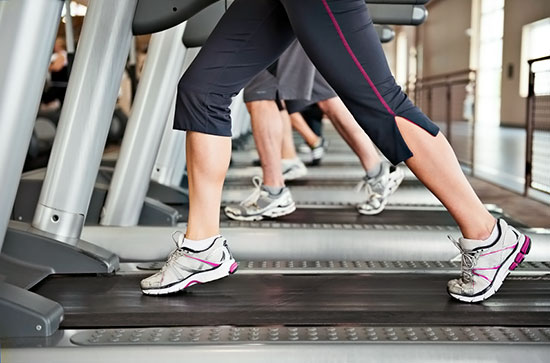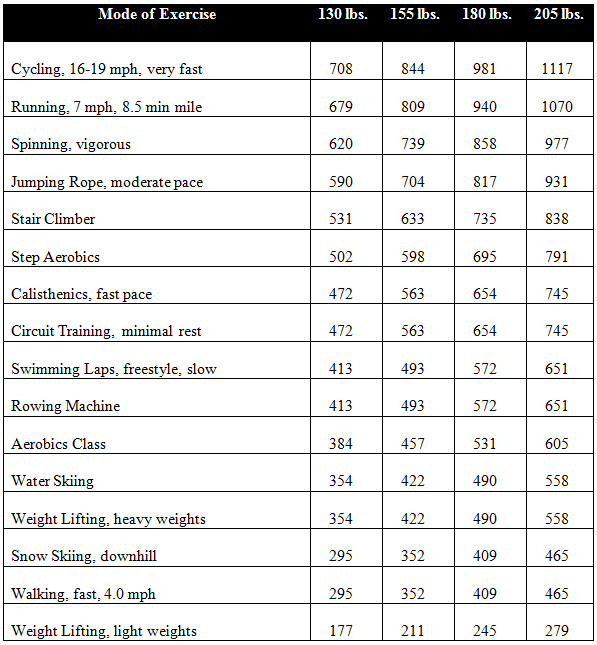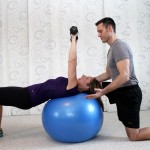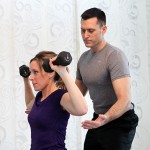Cardiovascular endurance is one of the 11 components of physical fitness that Bring It Home Personal Training teaches to all clients. Cardiovascular endurance can be improved by doing several types of aerobic conditioning. The chart below shows several different modes of exercise that will help to increase one’s cardiovascular endurance and improve overall physical fitness levels.
Aerobic conditioning, also called cardiorespiratory or cardiovascular fitness, is a good measure of the heart’s ability to pump oxygenated blood throughout the muscles. Oxygenated blood carries the nutrients the body needs to function effectively. A healthy heart can pump great volumes of oxygenated blood with each beat and will have a high level of cardiovascular fitness.
 Cardiovascular endurance is a health-related component of physical fitness and is directly related to the strength of your heart. Your cardiovascular endurance can be negatively affected by heart disease. Heart disease is directly associated with the cardiorespiratory and cardiovascular systems. One of the primary signs of heart and lung diseases include becoming winded with mild exertion. Individuals with heart or lung disease often become fatigued when performing day-to-day tasks that most of us take for granted. Aerobic exercise can help increase the body’s utilization of oxygenated blood pumping throughout the body, thus making our bodies stronger and more efficient performing everyday activities.
Cardiovascular endurance is a health-related component of physical fitness and is directly related to the strength of your heart. Your cardiovascular endurance can be negatively affected by heart disease. Heart disease is directly associated with the cardiorespiratory and cardiovascular systems. One of the primary signs of heart and lung diseases include becoming winded with mild exertion. Individuals with heart or lung disease often become fatigued when performing day-to-day tasks that most of us take for granted. Aerobic exercise can help increase the body’s utilization of oxygenated blood pumping throughout the body, thus making our bodies stronger and more efficient performing everyday activities.
Aerobic exercise can be as simple as walking or taking the stairs up to your office, or can be as strenuous as running a marathon or participating in a triathlon. The key point is to be healthy enough to do the activities you want to do.
Cardiovascular exercise should be done at least 3 days per week for minimal positive aerobic enhancement and reduction of body fat stores. For maximum results, intermediate and advanced trainees should be doing 5-6 days of cardiovascular conditioning per week, for a minimum of 30 minutes and not more than 60 minutes. Exercise modes include any physical activity (walking, jogging, inline skating, swimming, biking, etc.) that will get your heart rate up into your target heart rate zone. Improving your cardiovascular endurance alone is not enough to improve your overall physical fitness levels. Aerobic exercise along with a consistent strength training program and healthy eating will certainly help you to reach your health and fitness goals.
PLEASE CLICK HERE TO DETERMINE YOUR TARGET HEART RATE ZONE at www.active.com.
Benefits Of Cardiovascular Endurance Training:
- Improves blood pressure
- Decreases risk of developing colon cancer
- Reduced insulin needs
- Decreases risk of cardiovascular disease
- Lower mortality rates at all ages from all diseases
- Decreases serum triglycerides
- Helps to reduce body fat
- Increases HDLs (the good cholesterol)
- Improved glucose tolerance
- Decreases LDLs (the bad cholesterol)
- Enhances performance of work and recreational activities
- Relieves symptoms of depression and anxiety
Monitoring Aerobic Exercise Intensity
Monitoring your heart rate during exercise is the best indicator of aerobic exercise intensity. When you exercise, the heart beats faster to meet the demand for more oxygenated blood entering muscle cells in order for your body to keep up with intense physical activities. The higher the intensity level of activity, the faster your heart will beat to pump oxygen and blood throughout your body. Therefore, monitoring your heart rate during exercise is an excellent way to check your intensity level.
Maximal heart rate is a number related to your age. The human heart starts to beat more slowly as we age. Thus, the heart pumps oxygenated blood throughout the body less efficiently. To estimate your maximal heart rate, subtract your age from 220. Theoretically, this is the fastest your heart can beat in one minute without your body having negative side effects (dizziness, unconsciousness, heart attack, stroke, etc.)
Your target heart rate zone is the number of beats per minute (bpm) at which your heart should be beating during aerobic exercise in order to promote optimal fitness levels, improving cardiovascular conditioning, and reducing body fat percentages. For most healthy individuals, this range is 60-85% of the maximal heart rate.
Measuring your heart rate while exercising can be done through two methods. Wearing a heart rate monitor is the easiest and most accurate method of checking your heart rate. A heart rate monitor can be purchased at any sporting goods supplier and ranges from $40 to $200. The least expensive are very accurate and will only display your heart rate. The moderately and highly priced monitors offer a stop watch, warning sounds if your heart rate is too high or too low, standard clock, and many other features.
The second method for monitoring your heart rate is by checking your pulse on your radial artery. The radial pulse can be found on the under side of your wrist using your index and middle fingers held together. Once located, count the number of beats for 15 seconds and multiply that number by 4. This will give you your beats per minute. To be more accurate, count the number of beats in 60 seconds. Both methods are acceptable for determining your heart rate.
Now that you have determined your beats per minute (bpm), you must determine if you are exercising at an intensity within your target heart rate zone. Your target heart rate range is 60-85% of your maximal heart rate.
There are five types of Cardiovascular Endurance Training Zones:
Healthy Heart Zone (warm-up)
50-60% of one’s maximal heart rate. This is the easiest zone and is best for individuals just beginning a fitness program. It can be used as a warm-up for all sports and activities. This zone has been shown to help reduce body fat, blood pressure, and cholesterol in some individuals. Injuries are very unlikely to occur with people training in this zone.
Fitness Zone (fat burning)
60-70% of one’s maximal heart rate. This zone is more intense and burns more calories than the healthy heart zone. The benefits are the same, however individuals are at a slightly higher risk of injury. The approximate percentage of calories being burned from body fat is 85%. This is due to maintaining a low to moderate exercise intensity, thus a longer duration of exercise can be accomplished. Remember, the longer duration of aerobic activity, the more body fat stores will be used as energy.
Aerobic Zone (endurance training)
70-80% of one’s maximal heart rate. The aerobic zone will help to improve the body’s cardiovascular and respiratory systems. This zone will increase the size and strength of your heart, thus pumping oxygenated blood throughout your body more efficiently. There is a higher risk of injuries. Individuals training for endurance events will train at this level. Approximately 50% of calories being burned in this zone are from fat.
Anaerobic Zone (performance training)
80-90% of one’s maximal heart rate. Individuals training at this zone will see an improved VO2 max (the highest amount of oxygen one can consume during exercise). This will strengthen the cardiovascular system and increase lactic acid tolerance ability. Overall endurance will improve and you will be able to exercise at high intensities for longer periods of time. Approximately 15% of calories burned in this zone are from fat.
Red Line (maximum effort)
90-100% of one’s maximal heart rate. This zone is the most intense and grueling, however, it burns the most calories in the shortest period of time. A very small percentage of calories burned are from body fat. Most people will not be able to train in this zone for more than 45 seconds. Do not train in this zone.
Can you handle the training zone you are in?
Once you have determined your beats per minute (within 5 minutes of aerobic exercise), you must ask yourself a few questions:
- At this intensity, am I in my target heart rate zone? If not, make adjustments accordingly:
- Above zone, decrease speed or rpms (or incline)
- Below zone, increase speed or rpms (or incline)
- How do I feel?
- Can I maintain this pace for at least 30 minutes?
- Can I push myself to the upper limits of my target heart rate zone?
- If so, how long will I hold that upper limit?
Be aware of how your body feels and how you are breathing. If you cannot hold a conversation with someone without catching your breath, you may be going at too fast of a pace. This is what we call the “talk test”. This fast pace will cause you to run out of energy quickly, thus going a shorter duration and not burning off a higher percentage of calories from body fat stores. Remember, the longer duration of exercise, the more body fat stores will be burned off. Lower intensity aerobic exercise with a long duration (30-60 minutes) will help to burn more body fat stores.
Examples of Exercises that Improve the 11 Components of Physical Fitness and Caloric Expenditure
The following chart represents an estimate of caloric expenditure during specific exercises. Listed are 4 different body weight categories. Caloric expenditure is influenced by intensity, mode of exercise, one’s level of conditioning, metabolism, and body weight. All of the following exercises will help to improve all 11 components of physical fitness. Approximate caloric burn is represented in each box for each individual body weight shown.






